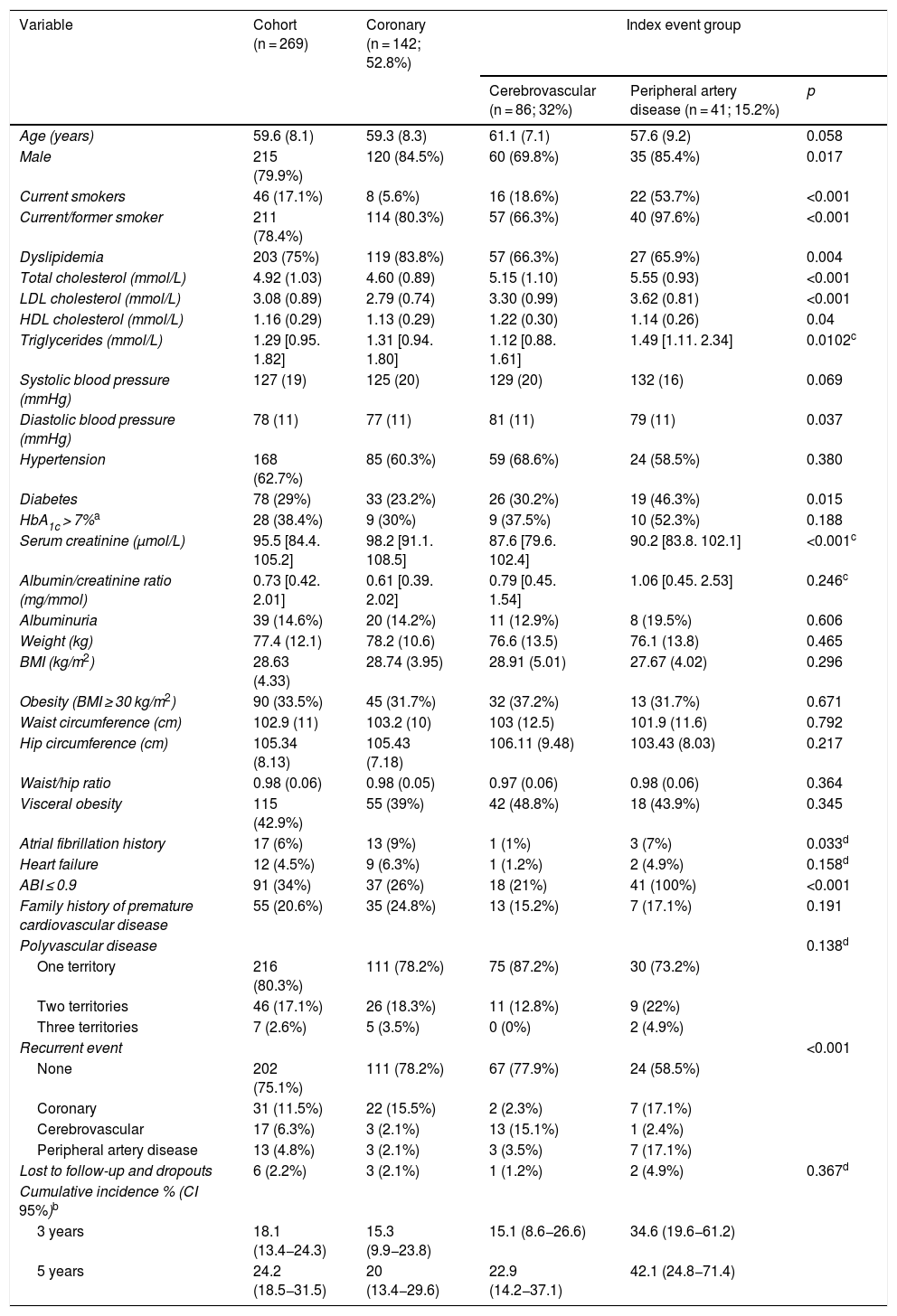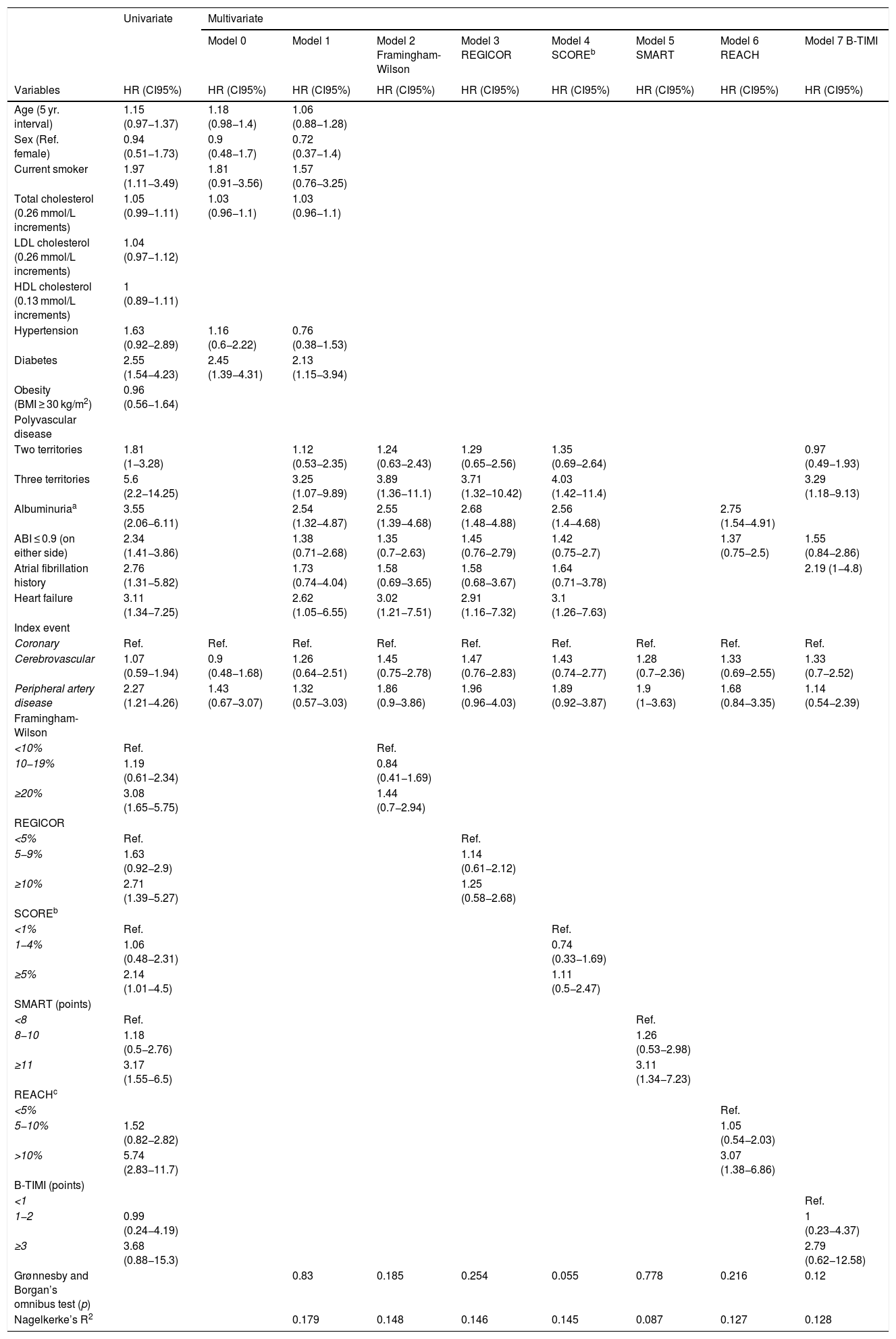There is no consensus regarding risk stratification tools for secondary prevention in atherosclerotic cardiovascular disease. Our aim was to compare the discriminative performance of the Framingham, REGICOR, SCORE, and REACH risk functions and the Bohula-TIMI and SMART risk scores, as well as to assess the potential added value of other clinical variables for the prediction of recurrent events in patients with established vascular disease.
MethodsA cohort of 269 patients with established vascular disease (52.8% coronary, 32% cerebrovascular, 15.2% PAD) was included. The survival functions of risk groups (low/medium/high) according to commonly used cutoff points for each function/score were compared, and hazard ratios for each were estimated using Cox regression. We calculated Δ Harrell’s C statistic, cat-NRI, and cNRI after adding new predictors to a base model including age, sex, total cholesterol, current smoking status, hypertension, and diabetes.
ResultsAfter six years of follow-up (median 4.82 years), 61 events occurred (23%). High-risk groups had a higher risk of recurrent event: SMART (HR: 3.17 [1.55−6.5]), Framingham (HR: 3.08 [1.65−5.75]), REGICOR (HR: 2.71 [1.39−5.27]), SCORE (HR: 2.14 [1.01−4.5], REACH (HR: 5.74 [2.83−11.7]), B-TIMI (HR: 3.68 [0.88−15.3]). Polyvascular disease (three territories HR: 5.6 [2.2−14.25]), albuminuria (HR: 3.55 [2.06−6.11]), and heart failure (HR: 3.11 [1.34−7.25]) also increased risk. Discrimination (Harrell’s C) was low but improved after adding albuminuria and polyvascular disease. Both variables also improved the performance of the base model (cNRI.326 [.036; .607]).
ConclusionsThe Framingham, REGICOR, SCORE, and REACH functions and the B-TIMI and SMART scores showed low yet similar performance in secondary prevention. Albuminuria and polyvascular disease improved the predictive performance of major classical cardiovascular risk factors.
En la enfermedad cardiovascular ateroesclerótica no existe consenso respecto a los instrumentos de estratificación del riesgo en su prevención secundaria. Nuestro objetivo consistía en comparar la capacidad discriminativa de las funciones de riesgo de Framingham, REGICOR, SCORE y REACH y las puntuaciones de riesgo Bohula-TIMI y SMART, así como en evaluar el posible valor añadido de otras variables clínicas en cuanto a la predicción de recurrencias en pacientes con enfermedad cardiovascular.
MétodosSe analizó una cohorte de 269 pacientes con enfermedad cardiovascular establecida (52,8% coronaria, 32% cerebrovascular, 15,2% arteriopatía periférica [AP]). Se compararon las funciones de supervivencia de los grupos de riesgo (bajo/intermedio/alto) según los valores de corte de uso habitual de cada función o puntuación y se calcularon las razones de riesgos instantáneos (RRI) correspondientes a cada una mediante regresión de Cox. Se calculó el Δ C de Harrell, el cat-IRN y el cIRN después de añadir nuevos factores predictivos a un modelo base que incluía edad, sexo, colesterol total, tabaquismo activo, hipertensión arterial y diabetes.
ResultadosAl cabo de seis años de seguimiento (mediana de 4,82 años) se habían producido 61 eventos (23%). Los grupos de riesgo alto tuvieron un mayor riesgo de recurrencia: SMART (RRI: 3,17 [1,55–6,5]), Framingham (RRI: 3,08 [1,65–5,75]), REGICOR (RRI: 2,71 [1,39–5,27]), SCORE (RRI: 2,14 [1,01–4,5], REACH (RRI: 5,74 [2,83–11,7]) y B-TIMI (RRI: 3,68 [0,88–15,3]). La enfermedad polivascular (tres territorios, RRI: 5,6 [2,2–14,25]), la albuminuria (RRI: 3,55 [2,06–6,11]) y la insuficiencia cardíaca (RRI: 3,11 [1,34–7,25]) también incrementaron el riesgo. La capacidad discriminativa (índice C de Harrell) fue baja, pero mejoró tras añadir la albuminuria y la enfermedad polivascular. Ambas variables también mejoraron el rendimiento del modelo base (cIRN: 0,326 [0,036; 0,607]).
ConclusionesLas funciones de Framingham, REGICOR, SCORE y REACH y las puntuaciones B-TIMI y SMART mostraron un rendimiento bajo, aunque similar, en prevención secundaria. La albuminuria y la enfermedad polivascular mejoraron el rendimiento predictivo de los principales factores de riesgo cardiovascular clásicos.
Article
Diríjase desde aquí a la web de la >>>FESEMI<<< e inicie sesión mediante el formulario que se encuentra en la barra superior, pulsando sobre el candado.

Una vez autentificado, en la misma web de FESEMI, en el menú superior, elija la opción deseada.

>>>FESEMI<<<











